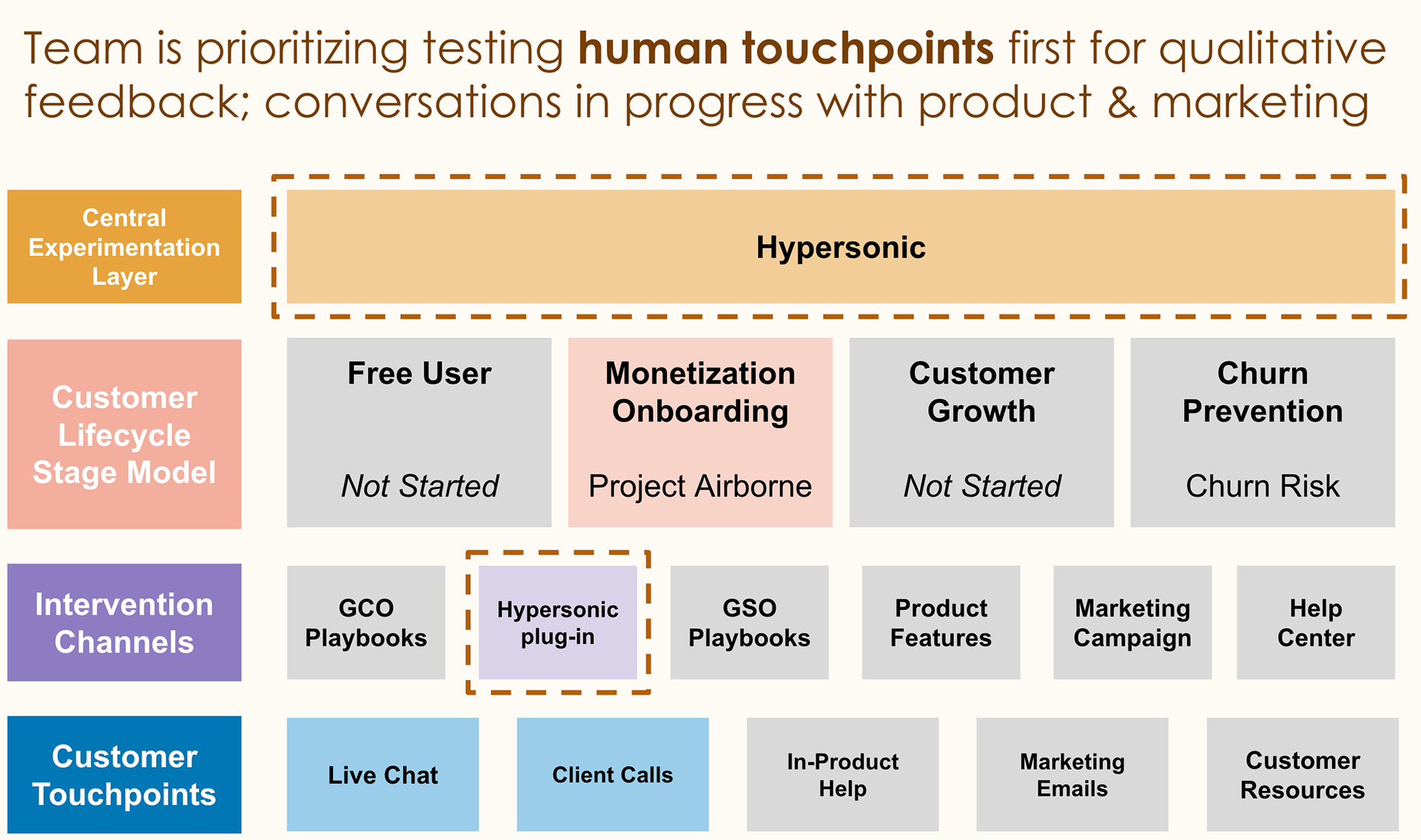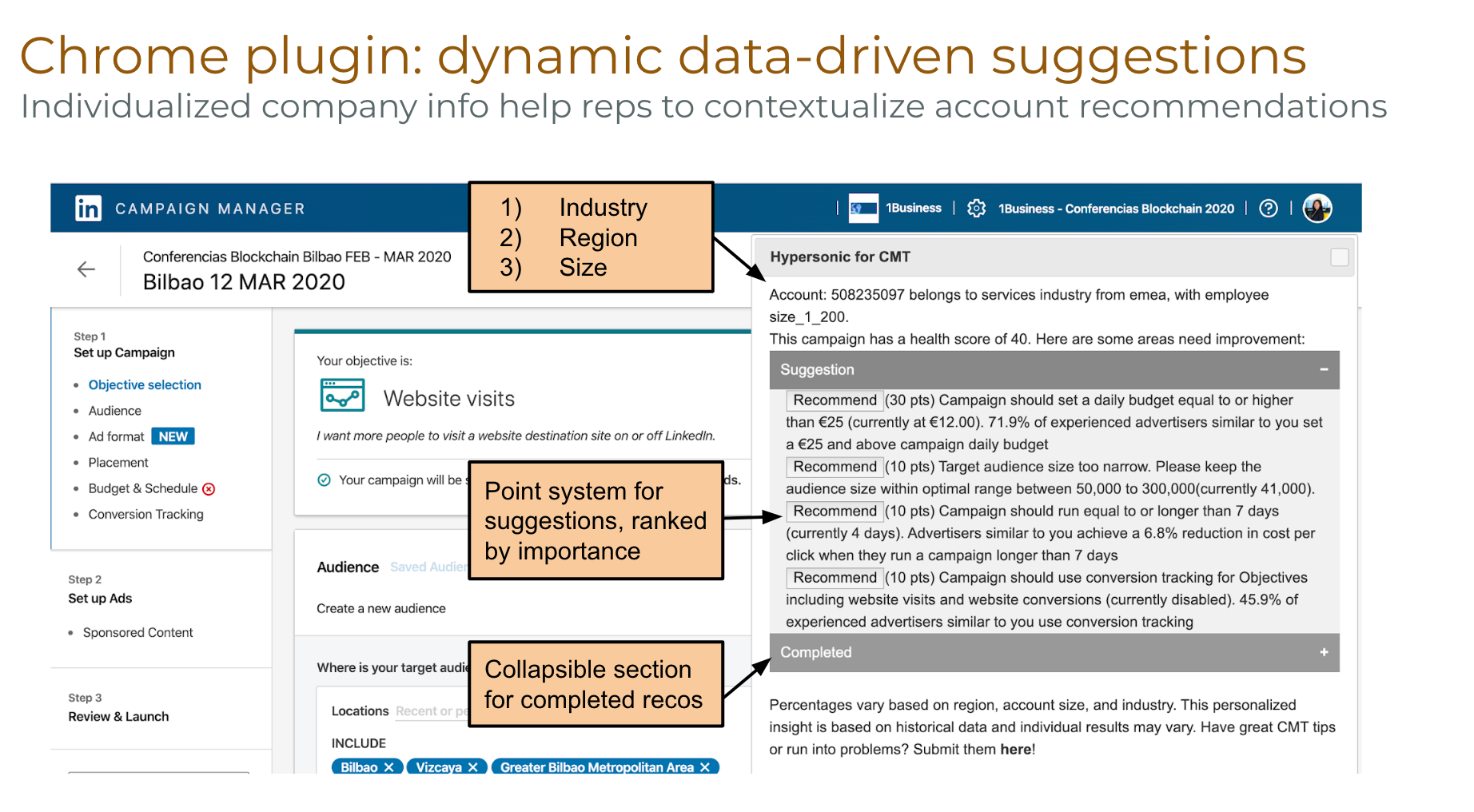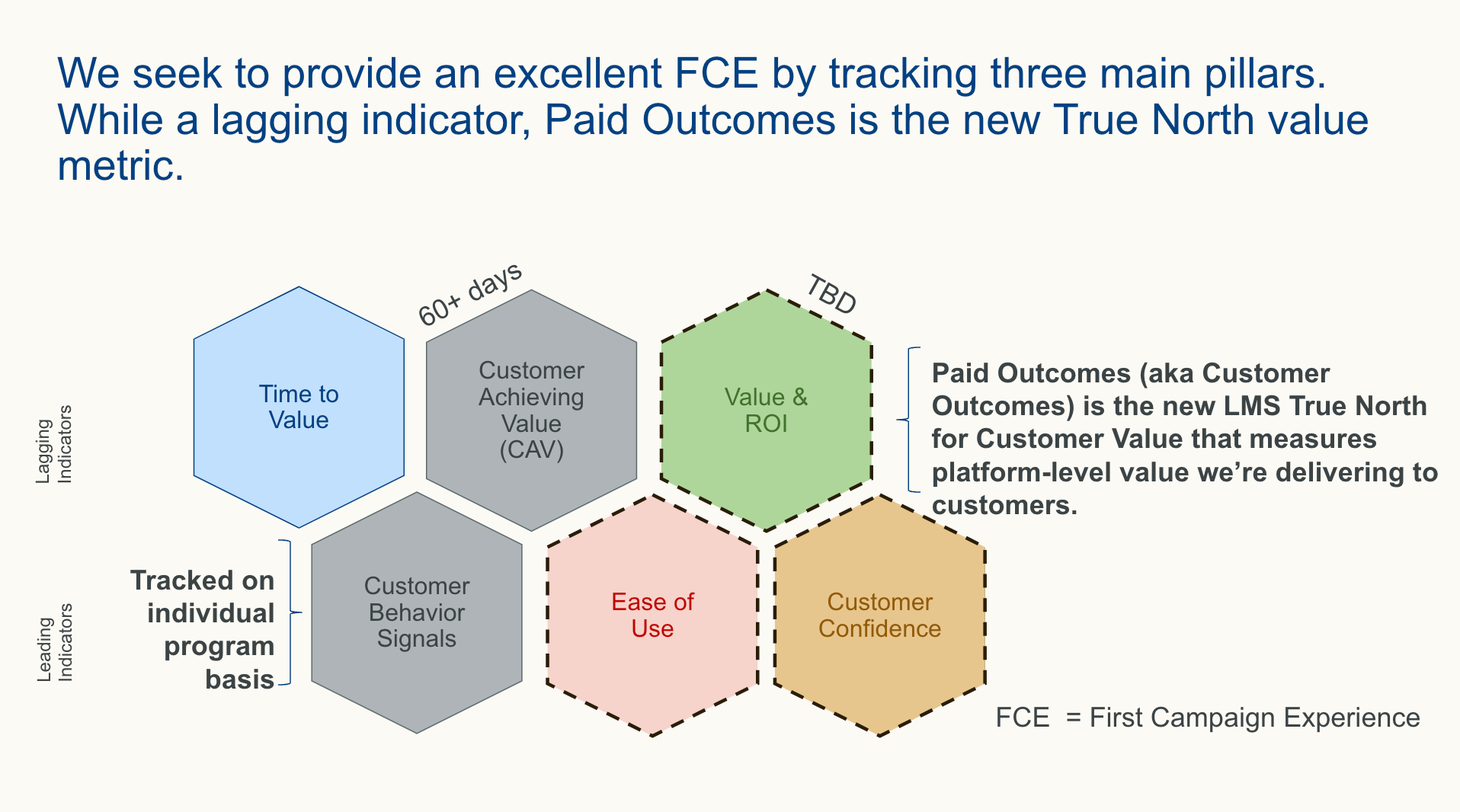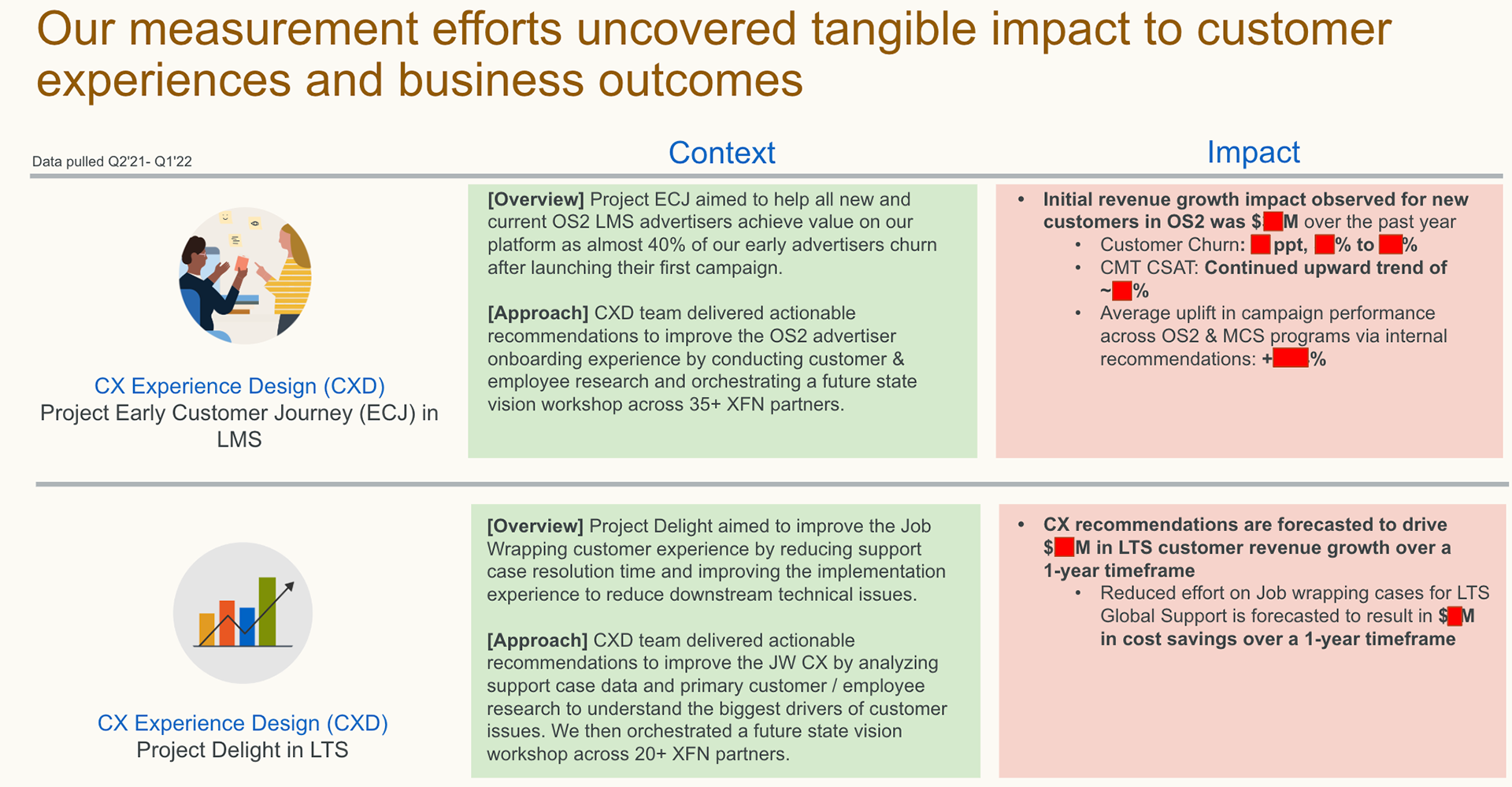CASE STUDY 1: Designing a New Experience for Sales Intelligence
One memorable project I led was named Project Hypersonic, for the hypergrowth that our online ad sales leadership team desired. I designed and launched a Chrome Plug-In sales intelligence tool to address key pain points for Sales & Customer Support teams and streamline their workflows with ready insights and customer recommendations. By deeply understanding customer challenges (in this case, marketers with ad campaigns on LinkedIn), I created an intuitive and efficient solution that directly improved productivity for our internal Sales & Customer Support teams. My work strongly focuses on crafting tools that solve real-world problems, aligning perfectly with Adobe’s mission to empower creatives with seamless, high-quality experiences.
SYSTEMS THINKING
Developing this tool required me to think systematically about the entire ecosystem. I built a comprehensive roadmap, prioritized tasks based on impact vs. feasibilty, and collaborated across teams (from data scientists to product to engineering to customer support) to ensure the tool integrated seamlessly into existing workflows. This systems-thinking approach proved fruitful in designing scalable, interconnected tools at LinkedIn.
USER-CENTERED DESIGN & FEEDBACK LOOPS
I placed the end-user (LinkedIn Sales & Customer Support teams) at the center of every design decision. By gathering feedback directly with focus groups, office hours, and live hands-on demos, I ensured the tool addressed real needs while remaining easy to use. I recognized that feedback loops were incredibly important for tool adoption, as is the ability to signal within the tool if there were data discrepancies or bugs. This iterative process of refining based on user input reflects my commitment to creating experiences that are not only functional but also delightful to use for anyone.
Data-Driven Design
Partnering with data scientists, I used analytics to guide my design decisions and measure success post-launch. We conducted 120-day looksbacks in historical data for prior company spend and created a comprehensive "Health Score" of user behavior. Embedded in this score was the ability to tell when a company was about to churn, based on paused ad spend and limited return on ad spend. We created additional indicators such as "Paid Outcomes" aka "Customer Outcomes" to assess the value provided to the customer. This data-driven approach allowed me to prioritize features that delivered the greatest impact and demonstrated tangible results, such as increased sales efficiency and improved user satisfaction. Leveraging data to inform design, and this aligns directly with how I approach problem-solving.
GTM Strategy and Communication skills
Beyond designing the tool, I took a leading role in its go-to-market strategy. I created training materials, playbooks, and newsletters to ensure smooth adoption and maximum impact. By clearly communicating the tool’s value and empowering teams to use it effectively, I played a pivotal role in its success. This experience mirrors the communication and leadership required to advocate for Adobe’s innovative products and tools.
Below are a few examples of the slides I made for the GTM Strategy, Executive Steering Committee presentations, and ongoing tool maintenance and development. These slides have minimal internal data and speak to the high-level strategy that I designed, socialized, and executed.





CASE STUDY 2: Transforming Customer experience and Creating ROI Frameworks
Several years go by. As a Manager on the CX team, I spearheaded a large-scale transformation initiative impacting 115+ stakeholders across multiple teams. By conducting in-depth customer and agency research, I reimagined the functional API ecosystem and led critical changes to the ads marketplace. This initiative not only streamlined workflows across all 35 members of the CX team, but also aligned cross-functional teams toward a unified vision, ensuring buy-in from all of our stakeholders. We were well-versed in experience design, journey management, and making sure that our partners knew all that we were capable of as the only end-to-end owners of the LinkedIn customer experience.
Driving Strategic Prioritization and Product Development
To align priorities across all product lines, I partnered with product design and engineering teams to host a 3-day prioritization workshop. It was imperative that the fragmented internal employee experience did not reflect to our customers. The admission of this fact led to several positive outcomes. The main outcome was the development of 35 new roadmap features for the LinkedIn Flagship product and Campaign Manager platform that addressed immediate pain points while setting a long-term vision for growth and scalability. My ability to bring diverse voices together ensured that the roadmap was both innovative and actionable.


CREATING A DATA-DRIVEN CX FRAMEWORK
I developed a comprehensive Customer Experience (CX) Business Impact & ROI framework to measure success and guide future improvements. I largely thought about splitting up the metrics based on "Increasing Costs", "Decreasing Costs", and "CX Proxy Metrics" to cover as much ground as possible. By leveraging 20 efficiency-related KPIs-including First Call Resolution (FCR), Average Handle Time (AHT), Self-Serve Adoption / Campaign Creation Rates, and Employee Satisfaction (ESAT)-I ensured that every decision was rooted in measurable outcomes that all teammates were able to weigh in on. This framework not only demonstrated the value of CX investments but also provided a roadmap for ongoing optimization.
I managed multi-million-dollar budgets to cover contractor run rates, software investments, learning and development (L&D) programs, and team morale activities. By optimizing budget allocation, I was able to enhance the team’s efficiency and culture simultaneously, fostering a high-performing, engaged CX organization.
Other works completed at LinkedIn (November 2019 - July 2024)
‣Early Customer Journey: Redesigned and imagined the 1st campaign experience for new business owners.
‣Customer Canary Metrics: Set KPIs for organizational health to determine ongoing growth for early churn.
‣CX Business Impact Analysis: Calculated total business impact of 35 team members and analyzed value add.
‣Great APE (API Partner Experience): Facilitated new journey design for API Partners to receive better visibility.
‣Project Airborne: Co-led Data Science study for customer behaviors signaling successful campaign creations.
‣OSO (Online Sales Organization) Strategy: Implemented strategic projects for long-tail online customers.
⭐️LinkedIn (Q2FY22) Results Award for MCXO (Members Customer Experience Org) All Hands
Date Received: December 2021
✨This award primarily recognize individuals in MCXO who have exceeded performance targets & enabled outsized business impact in the past quarter, while upholding LinkedIn's Culture and Values. These individuals consistently go above & beyond to ensure our members are the first priority. They operate with a growth mindset, proactively exploring opportunities to expand her role in the spirit of creating more value for MCXO and our key stakeholders.
⭐️LinkedIn (Q1FY22) Sales Kickoff Nomination for Leadership AWARD
Date Received: September 2020
✨Nominees demonstrate strategic vision, guiding their teams toward achieving key business objectives while fostering an environment of growth and collaboration. Their ability to inspire, mentor, and develop talent is evident in the success of their teams. "Jane has been remarkable through her leadership of this project. This pilot program was executed on a shoestring budget. Jane's focus, work ethic, and passion about the project was what led this seed of an idea to amazing maturity."